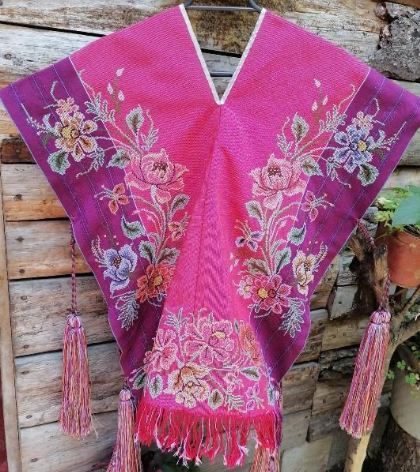
Traditional Pok´u´l garment from Zinacantán
On May 20th, 2023, the DIOR brand presented its “Cruise Collection 2024” by Maria Grazia Chiuri at the Antiguo Colegio de San Ildefonso in Mexico City with a collection of garments inspired by Mexican culture (with an emphasis on Frida Kahlo and feminism). Part of the presentation was with handmade textiles where they mention that they collaborated with different artisans from the states of Oaxaca, Puebla and Chiapas.
The “Cruise Collection 2024” includes a Tsotsil male garment belonging to the municipality of Zinacantán in the State of Chiapas, called POK’U’UL/POK’U’IL. In the collection the clothing is worn by a female model in addition to presenting small changes and mutilations; the center slit is longer than normal (unlike how the men from Zinacantán wear it), the ¨snich¨ (tassels that hang from the sides and join each side of the garment) cut in half, and a belt was added. Given this, it is revealed that the garment was made in collaboration with artisans from the Sna Jolobil cooperative in San Cristóbal de Las Casas, Chiapas, emphasizing the credits for the elaboration of the garment to Mr. Pedro Meza, a person from the municipality of Tenejapa, that is, someone from outside the municipality of Zinacantán, who calls it an “overcoat” ignoring the real name used by the wearers of this garment; pok’u’ul/pok’u’il.
On María Crazia Chiuri’s Instagram account, she mentions, “For the latest collection we have collaborated with Don Pedro and the Sna Jolobil weavers based in Chiapas, to create a reinterpretation of the iconic Dior Bar Jacket.” We can then deduce a clear plagiarism/appropriation, because this garment that they presented and which they called an “overcoat”, is nothing more and nothing less than the aforementioned pok’u’ul. We can see that both the shape in the design, the flowers, the colors and all the elements it presents belong to this clothing.
It is, without doubt, an appropriation of the pok’u’ul design. Taking this garment from the traditional clothing of Zinacantán, they made slight modifications and labeled it as their own creation, mentioning inspiration and collaboration. Mr. Pedro Meza, despite someone who clearly knows these issues and who has been in this line of work for more than thirty years, found it easy to take an existing garment, assign a name (banalization and de-authentication) and recreate it as his own design or as the work of his cooperative, Sna Jolobil. For these reasons, Pedro Meza is responsible for and complicit in the trivialization, de-authentication, appropriation, and plagiarism of this Zinacantán textile piece.
Federal Law for the Protection of the Cultural Heritage of Indigenous and Afro-Mexican Peoples and Communities
In order to avoid plagiarism and the appropriation of the cultural heritage of indigenous peoples that has been taking place in previous years and up to the present, 2023, on January 17th, 2022, the Law on Federal Protection of the Cultural Heritage of Indigenous and Afro-Mexican Peoples and Communities was published in the Official Gazette of the Federation, where cultural heritage is defined as: “the set of tangible and intangible goods that include languages, knowledge, objects and all the elements that constitute cultures and territories of indigenous and Afro-Mexican peoples and communities, which give them a sense of community with their own identity and which are perceived by others as characteristic, to which they have the full right of ownership, access, participation, practice and enjoyment in an active and creative manner”, (Article 3, Section XII).
The misappropriation of cultural heritage is defined as: “the action of a natural or legal person, national or foreign, by means of which they appropriate for themselves or for a third party, one or more elements of cultural heritage, without the authorization of the indigenous or Afro-Mexican people or community…” (Article 3, Section I).
In the same federal law, it is outlined that in order to make use of one or more elements of the cultural heritage of an original people, it is important to have the consent of the people and/or of the communities to which it belongs. Such consent must be informed and made in advance, where peoples and communities have at all times the right to grant or not consent to the use of any element of their cultural heritage.
What happened with the Zinacantán garment, with this supposed “inspiration” and “collaboration” with artisans from this municipality made with the DIOR brand, is a lie to excuse the obvious cultural appropriation. It is a fact that it was carried out in a context of ignorance and misinformation on the part of DIOR, the Ministry of Culture (and the institutions involved), as well as the people involved in it, ignoring what is established In the Law on Federal Protection of the Cultural Heritage of Indigenous and Afro-Mexican Peoples and Communities.
As artisans and communities of Zinacantán culture, we are outraged to see this type of action and we call what happened cultural appropriation, since it is part of our cultural heritage and is also an important element in the identity of our people, it has a historical charge, a sentimental, ceremonial and hereditary value for us.
We ask the authorities of the three levels of government and those involved to clarify the facts, since the collective rights of the municipality of Zinacantán have been violated, we pronounce ourselves under the following requests:
• That the aforementioned brand names the garment with the correct name and states that the design is not its authorship or that of any of its collaborators.
• That the government institutions in charge of the care of cultural patrimony pronounce themselves in favor of the request.
• That the relevant investigations be carried out for said collaboration as it was not carried out with prior, free and informed consultation with the entire municipality of Zinacantán, with one person and his cooperative benefiting from this fact.
It is also important to clarify that:
Any person foreign to the language and culture of Zinacantán can buy/acquire or use the traditional clothing of the town as long as it is not done for commercial purposes and within a framework of respect for cultural heritage.
We are not against people and companies in the fashion industry finding inspiration in Zinacantán clothing and wanting to collaborate with artisans, but that “collaboration” and “inspiration” should not be based on mutilation and modification, traditional garment designs or cultural/intellectual extractivism. We demand that they do true collaborative, horizontal work without intermediaries.
This is cultural/intellectual appropriation and extractivism!
THIS IS NOT AN ACHIEVEMENT FOR OUR PEOPLE AND COMMUNITIES OF ZINACANTÁN, IT IS AN ABUSE AND DISPOSSESSION OF OUR CULTURAL HERITAGE!
Organized Civil Society of Zinacantán Culture
Translated by Schools for Chiapas.
